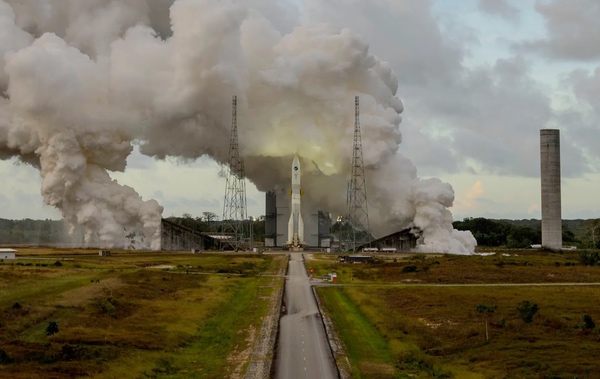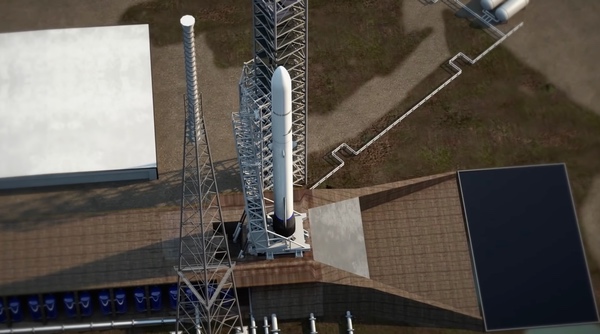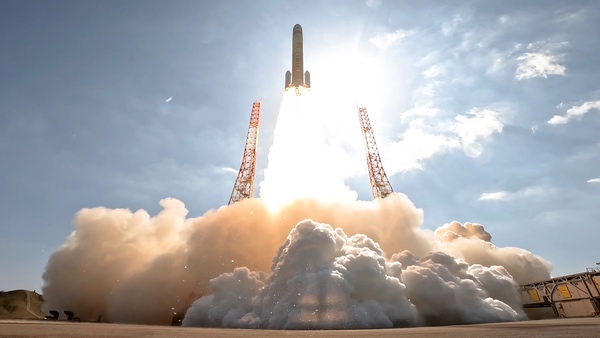
The year new launch vehicles finally lift offby Jeff Foust
|
| “We did take some risk on the launch going with a new vehicle, but we are comforted with the fact that it is United Launch Alliance and they have a really stellar track record of success,” said Astrobotic’s Thornton. |
ULA had planned to launch Peregrine last month, with a launch early on Christmas Eve. However, the company had to cut short a fueling test and practice countdown known as a wet dress rehearsal (WDR) in early December because of problems with ground systems. “I’d like a FULL WDR before our first flight, so XMAS eve is likely out,” ULA CEO Tory Bruno posted on social media. ULA later confirmed it would not launch in the three-day window centered around Christmas so it could complete the WDR.
The launch will send Peregrine to the Moon and also serve as the first of two certification flights of the rocket before it can launch national security payloads (ULA has designated this launch Cert-1.) The second, as soon as this spring, will be the first flight of Sierra Space’s Dream Chaser cargo vehicle to the International Space Station.
One of the key goals of Cert-1 will be to test out the new Centaur V upper stage. “There will be additional maneuvers performed just to give us an opportunity to exercise the Centaur V,” Bruno said in a call with reporters in November, “really verify but mostly learn about its quirks as we go put it through its paces in preparation for missions that’ll come later.”
In that call, Bruno outlined ambitions to quickly ramp up the Vulcan’s launch rate to serve its customer, including both national security missions and Amazon’s Kuiper satellites. He projected being able to launch twice a month by the end of 2025.
Vulcan is critical to ULA’s future as it phases out the Atlas and Delta vehicles. It also comes as ULA itself, a joint venture of Boeing and Lockheed Martin, may be up for sale, with potential acquirers rumored to include Blue Origin, private equity firm Cerebus, and defense contractor Textron.
Bruno, in the call, declined to comment on a potential sale of the company. “I could never talk about or even speculate about the merger or acquisition situation,” he said. “I did say that ULA is in great shape after our transformation and our full, now many years long, presence in the commercial marketplace.”
The launch is just as important to Astrobotic, which will be sending its first lander to the Moon and the first that is part of NASA’s Commercial Lunar Payload Services (CLPS) program. “We did take some risk on the launch going with a new vehicle, but we are comforted with the fact that it is United Launch Alliance and they have a really stellar track record of success,” John Thornton, CEO of Astrobotic, said in a media teleconference about the mission in November. “We are very confident on that launch, but I can tell you I’ll be on the edge of my seat on that launch.”
 An Ariane 6 prototype performs a long-duration static-fire test in November on its launch pad in French Guiana. (credit: ESA) |
Delays in the Ariane 6 have put Europe in a bind. With the Ariane 5 retired after a final launch in mid-2023, the Soyuz unavailable after Russia’ invasion of Ukraine, and Vega C still grounded after a December 2022 launch failure, Europe is effectively without its own means to access space. That led the EU to buy the Falcon 9 launches of Galileo satellites in November and ESA to buy several Falcon 9 launches for its science missions, like Euclid last July (see “A crisis and an opportunity for European space access”, The Space Review, July 10, 2023.)
The Ariane 6, though, is now making steady progress towards its first launch. A test model of the rocket fired its core stage engine for more than seven minutes during a November 23 static-fire test on the launch pad in French Guiana. While the test stopped short of the planned duration of nearly eight minutes—which ESA later attributed to a faulty sensor and “very conservative” test thresholds—the agency called the test a success.
That allowed ESA and prime contractor ArianeGroup to set a date for the first launch: between June 15 and July 30 of this year. That launch will carry several small satellites.
If that launch is a success, a second Ariane 6 launch could take place before the end of the year, carrying a French reconnaissance satellite. Officials said in the November 30 announcement of the new launch date that they will attempt “as many flights as possible” of Ariane 6 in 2025, including of Kuiper satellites.
| “One should not underestimate the decisions of Seville,” said Aschbacher of support for the Ariane 6 secured at the Space Summit. |
The test came after ESA member states shored up the finances of the Ariane 6. At a Space Summit meeting in Seville, Spain, November 6, ESA announced an agreement where it would agree to provide up to 340 million euros ($372 million) a year to support production of a tranche of 27 vehicles while also committing to four institutional, or government, launches a year. That agreement also included plans for a “launcher challenge” that will open up future launches that once would have gone to Ariane 6 to competition (see “Europe turns to competition to improve its launch industry’s competitiveness”, The Space Review, November 27, 2023.)
“One should not underestimate the decisions of Seville,” Josef Aschbacher, director general of ESA, said at the briefing where the agency announced the date for the first Ariane 6 launch. “To have this access to space guaranteed now throughout the decade, both for the Ariane 6 and the Vega C launchers, is fundamental.”
There are still obstacles to overcome before that first Ariane 6 launch. A static-fire test of the rocket’s upper stage in early December was abort after two minutes. ESA said the cause of the abort was under investigation but the agency was optimistic that it would not affect the first launch since the test was examining the upper stage’s performance in “degraded” conditions.
“There are no signs that it will delay the announced inaugural flight date,” said Toni Tolker-Nielsen, ESA director of space transportation, at a December 14 briefing.
 An illustration of New Glenn on its launch pad. (credit: Blue Origin) |
Blue Origin’s New Glenn rocket, like Ariane 6 and Vulcan, was at one point slated to make its debut in 2020. The company is now looking to the second half of 2024 for that rocket to finally fly.
| “Blue Origin needs to be much faster, and it’s one of the reasons that I left my role as the CEO of Amazon a couple of years ago,” said Bezos. “Blue Origin needs me right now.” |
The likely payload for the first launch is a NASA Mars smallsat mission called ESCAPADE (Escape and Plasma Acceleration and Dynamics Explorers) under a contract NASA awarded in February 2023. That launch has been scheduled for August, although some recent presentations showed it could take place as late as November 2024.
“We will very likely be the very first launch of New Glenn,” said Bradley Smith, director of NASA’s Launch Services Office, at an advisory committee meeting in November. “It’s an incredibly ambitious first launch for New Glenn and we really appreciate the partnership.”
He acknowledged “some schedule risk” for that launch, but declined in the meeting to estimate the chances it would launch on schedule. He added he has seen Blue Origin’s schedule for the vehicle but did not disclose details about it.
There is increased urgency at Blue Origin to get New Glenn flying, coming from the very top. “Blue Origin needs to be much faster, and it’s one of the reasons that I left my role as the CEO of Amazon a couple of years ago,” Jeff Bezos, founder of Blue Origin, said in a December 14 interview with podcaster Lex Fridman. “Blue Origin needs me right now.”
Bezos said he was “very optimistic” New Glenn would launch some time in 2024, but declined to confirm the NASA comments that ESCAPADE would be on the first launch. He said the company was considering several other unspecified payloads for that inaugural flight.
Whatever the payload, he admitted he was nervous about that launch. “A lot of the problems that we might find in flight have been resolved, but there are some problems you can only find in flight,” he said. “So, cross your fingers. I guarantee you you’ll have fun watching it no matter what happens.” (A remark that drew parallels to Elon Musk’s “excitement guaranteed” comments about the first Starship launches.)
Blue Origin also has new leadership. In September, Bob Smith announced he would step down as CEO after six years. He was replaced by Dave Limp, a former Amazon executive whose portfolio there included Project Kuiper. “He’s amazing. We’re super-lucky to have Dave,” Bezos said of Limp. “You’re going to see us move faster there.”
 Japan’s H3 lifted off in March on its inaugural flight, but the vehicle failed deliver its payload into orbit when its upper stage failed to ignite. (credit: JAXA) |
Lost in anticipation about the long-awaited first launches of Ariane 6, New Glenn, and Vulcan has been Japan’s H3. That rocket did make its debut last March, only to suffer a failure of its upper stage that destroyed its payload, the $200 million ALOS-3 Earth science satellite (see “A review of Japan’s space policy after the H3 launch vehicle failure”, The Space Review, June 5, 2023.)
/article/4595/1
The Japanese space agency JAXA and H3 prime contractor Mitsubishi Heavy Industries (MHI) have provided few details about the cause of the failure, other than an electrical issue of some kind prevented the upper stage’s engine from igniting. That apparently also affected the existing H-2A vehicle, which was grounded for several months after the H3 failure.
“We defined the corrective actions and some of them applied to the H-2A launch vehicle,” said Iwao Igarashi, vice president and general manager of MHI, at the World Satellite Business Week conference in September, just after the H-2A resumed launches. “The next step is we are working hard to prepare for the return to flight” of the H3.
JAXA announced last week a date for the H3’s return to flight: February 15. This time, the rocket will be carrying only a test payload, Vehicle Evaluation Payload-4, and two smallsats. A successful launch is essential to ensure a JAXA Mars mission, Martian Moons eXploration, can launch as scheduled this September.
In the meantime, SpaceX plans to continue to increase the rate of Falcon launches. In testimony before a Senate committee in October, Bill Gerstenmaier, a former NASA official who is now SpaceX’s vice president of build and flight reliability, said the company was aiming to conduct 12 launches a month in 2024, or 144 for the year. By contrast, it may take some luck for Ariane 6, H3, New Glenn, and Vulcan to perform 12 launches combined this year.
Note: we are using a new commenting system, which may require you to create a new account.